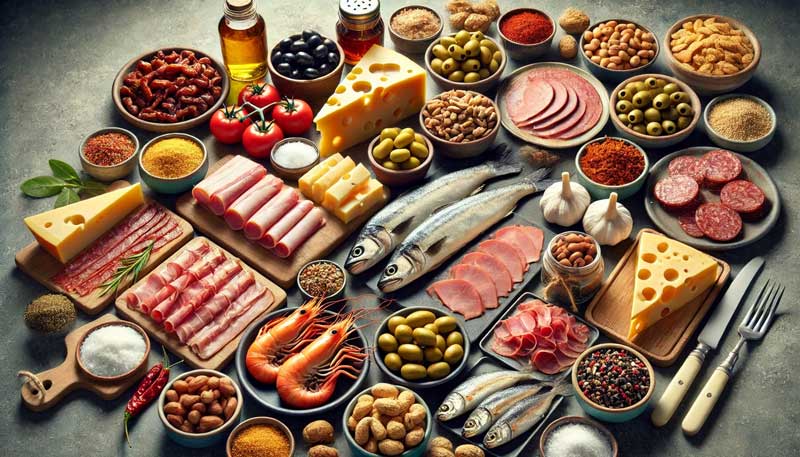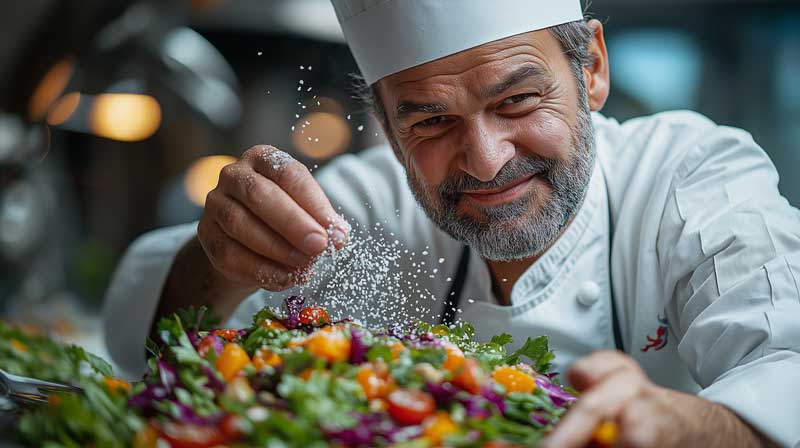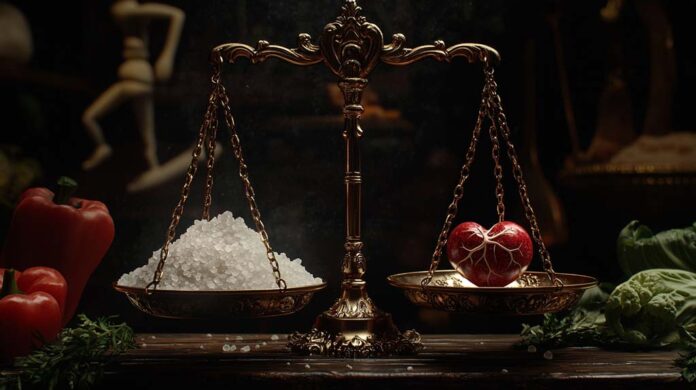Salt intake balance is a crucial yet often overlooked aspect of our health. This realisation struck me recently while reading Seth Godin’s blog post “Omitting the herbs“. His opening line, “Without salt, human beings don’t survive long,” set my analytical mind whirring.
Godin’s seemingly simple statement carries profound implications. If we can’t survive without salt, its role in our bodies is far more complex than we often consider. This got me thinking: What’s the whole story behind salt’s necessity and potential risks?
As I pondered this, the paradox became clear. While sodium, a key component of salt, is essential for vital bodily functions, excessive intake can be harmful. This dichotomy fascinates me. How can something so necessary also be potentially dangerous?
My analytical thinking revealed that sodium plays critical roles in fluid balance, nerve function, and muscle contraction. Yet, too much can lead to high blood pressure and other health issues. As a health enthusiast and analytical thinker, this delicate balance intrigues me. I realised that the challenge lies in understanding and achieving optimal salt intake balance. It’s not about elimination or excess but finding that sweet spot where our bodies function at their best.
This nuanced approach to salt consumption reflects a broader truth about health and nutrition.
This post will explore the science behind salt’s dual nature in our bodies. We’ll unpack its essential functions, examine the risks of both deficiency and excess and discuss practical strategies for maintaining a healthy balance. Join me on this journey of discovery as we unravel the complex relationship between salt and our health.
The Essential Role of Sodium in Salt Intake Balance
Sodium: The Unsung Hero of Bodily Functions
Sodium, a key component in salt intake balance, is crucial in our body’s daily operations. As an athlete, I’m acutely aware of its importance. I rely on hydration tablets during intense training sessions to replenish lost electrolytes.
These effervescent tablets, dissolved in water, provide the optimal sodium concentration (30mmol/L) for superior hydration. This scientific approach ensures I maintain peak performance, especially on hot days when sweat loss is significant.
Critical Roles of Sodium:
- Fluid Balance: Sodium regulates blood volume and helps maintain proper hydration.
- Nerve Function: It’s essential for transmitting nerve impulses throughout the body.
- Muscle Contraction: Sodium facilitates muscle contractions, which is crucial for athletic performance.
- Nutrient Absorption: It aids in absorbing certain nutrients in the small intestine.
The Domino Effect of Sodium Deficiency
While excessive sodium can be harmful, a deficiency can wreak havoc on our bodies. As someone who engages in endurance sports, I’ve learned the importance of balancing salt intake. I use electrolyte powders during long sessions to prevent dehydration and maintain energy levels.
Consequences of Sodium Deficiency:
- Hyponatremia: A potentially dangerous condition causing confusion and seizures.
- Muscle Cramps: Inadequate sodium can lead to painful muscle contractions.
- Decreased Performance: Low sodium levels can significantly impact athletic endurance.
- Cognitive Issues: Severe deficiency may cause headaches and difficulty concentrating.
Striking the Right Balance
Achieving optimal salt intake balance is crucial for overall health. While the average daily sodium intake in many countries exceeds recommendations, it’s important to note that individual needs may vary.
For instance, my sodium requirements are higher as an active individual than someone with a sedentary lifestyle. I adjust my intake based on my activity level and climate conditions, ensuring I maintain the delicate balance necessary for peak performance and health.

Risks Associated with Excessive Salt Consumption
The Hidden Dangers: When Salt Intake Balance Tips
Excessive salt consumption poses significant health risks, often lurking behind our favourite foods. While salt intake balance is crucial, many exceed recommended levels without realising it.
The chart above starkly illustrates this global issue. It compares the WHO’s recommended daily salt intake with the global average consumption, revealing a troubling disparity that emphasises the urgent need for increased awareness and dietary changes.
Startling Statistics:
- Global average salt intake: 9-12 grams per day
- WHO recommended intake: Less than 5 grams per day
- Excess-related deaths: 1.89 million annually
The Silent Killer in Our Diet
High sodium intake is the leading dietary risk factor for cardiovascular disease worldwide. It’s a sobering thought that our salt shakers could be ticking time bombs for our health.
Health Risks of Excessive Salt Consumption:
- Hypertension: The primary effect of high sodium is raised blood pressure.
- Cardiovascular Diseases: Increased risk of heart attacks and strokes.
- Kidney Disease: Excessive salt strains the kidneys’ filtering capacity.
- Osteoporosis: High salt intake may increase calcium excretion, weakening bones.
- Stomach Cancer: Some studies suggest a link between high salt intake and gastric cancer.
Beyond Blood Pressure: Salt’s Far-Reaching Effects
Research indicates excessive salt can harm our bodies even without raising blood pressure. It can adversely affect our arteries, heart, skin, and brain.
Salt’s Impact on Different Organs:
- Arteries: Impaired endothelial function, potentially leading to atherosclerosis.
- Heart: Increased left ventricular mass, a risk factor for heart failure.
- Skin: Non-osmotic sodium accumulation, possibly linked to inflammation.
- Brain: Potential impairment of cerebrovascular function.
The Global Salt Crisis
The World Health Organization paints a grim picture: almost everyone consumes too much sodium. The global mean intake for adults is a staggering 4,310 mg/day – more than double the WHO recommendation.
Achieving a salt intake balance is crucial for public health. By reducing global salt consumption to recommended levels, we could avert up to 2.5 million deaths from heart attacks and strokes annually.

The Challenge of Achieving Optimal Salt Intake
Achieving optimal salt intake balance poses a significant public health challenge. Despite widespread initiatives, global consumption remains stubbornly high.
The hidden salt epidemic lurks in our everyday foods. Shockingly, 75% of dietary salt comes from processed items, not the table shaker. This makes achieving balance particularly challenging for consumers.
Common high-salt culprits include:
- Anchovies, olives, pickles
- Bacon, ham, salami
- Cheese, gravy granules, stock cubes
- Salted nuts, crisps
- Smoked meat and fish
- Soy sauce, condiments
However, the list continues. Many staple foods harbour hidden salt:
- Bread products (crumpets, bagels, ciabatta)
- Pasta sauces, ready meals
- Pizza, sandwiches
- Breakfast cereals, soups
- Sausages, cold cuts
This prevalence of hidden salt complicates public health messaging. Although 96 countries report national salt reduction initiatives, progress must be made faster.
Moderation is essential, yet achieving it proves difficult. The World Health Organization’s ambitious goal of reducing the population’s salt intake by 30% by 2025 faces significant hurdles.
Strategies like food reformulation, consumer education, and front-of-pack labelling show promise. However, these efforts often must overcome industry resistance and ingrained consumer habits.
Interestingly, controversy surrounds lower salt intake and cardiovascular outcomes. Some experts call for large-scale dietary salt-feeding trials to settle ongoing debates.
However, conducting such trials faces significant challenges. Long-term compliance, practical monitoring issues, and ethical concerns about controlled populations complicate these efforts.
Factors Influencing Individual Salt Intake Balance
Salt intake balance is not a one-size-fits-all equation. Various factors significantly impact an individual’s optimal sodium needs, complicating public health efforts to establish universal guidelines.
Age: A Shifting Landscape of Salt Requirements
Salt needs to evolve dramatically throughout our lifespan:
- 0-6 months: Less than 1g/day
- 1-3 years: 2g/day
- 4-6 years: 3g/day
- 7-10 years: 5g/day
- 11 years and over: 6g/day
These age-based recommendations reflect the body’s changing ability to process and utilise sodium. Infants and young children are susceptible to excess salt, while adolescents and adults require more to maintain proper bodily functions.
Health Conditions: When Salt Becomes a Double-Edged Sword
Certain health conditions dramatically alter the body’s relationship with sodium. Hypertension, heart failure, and kidney disease often necessitate strict salt management. Paradoxically, some conditions may increase sodium needs, highlighting the complexity of salt intake balance in medical contexts.
Lifestyle Factors: The Hidden Influencers
Activity level and climate play crucial roles in determining optimal salt intake. Intense exercise or hot environments can lead to significant sodium loss through sweat, potentially increasing requirements. Conversely, sedentary lifestyles or cooler climates may reduce sodium needs.
Diet composition also significantly impacts salt intake balance. The prevalence of processed foods in modern diets often leads to inadvertent overconsumption of sodium, making it challenging to achieve optimal levels without careful consideration.
Demographic Influences: The Population Puzzle
Research reveals intriguing patterns in salt intake across populations. A distinct gender gap exists, with men often consuming significantly more salt than women. In some European countries, this difference exceeds 2g daily.
Age-related changes in salt sensitivity further complicate the picture. As we age, our bodies become more responsive to sodium’s effects, potentially altering optimal intake levels. This shift highlights the need for age-specific approaches to salt intake balance.
The relationship of these factors creates a complex web of considerations for achieving optimal salt intake. It challenges us to move beyond simplistic guidelines and embrace a more nuanced, personalised approach to sodium consumption.

Practical Strategies for Maintaining Healthy Salt Intake Balance
Balancing salt intake presents a formidable challenge in our sodium-rich food landscape. Yet, we can achieve healthier consumption patterns without sacrificing flavour with informed choices and creative culinary approaches.
The World Health Organization recommends adults consume less than 2000 mg of sodium daily, equivalent to about 5g of salt. However, most people significantly exceed this guideline, often unknowingly.
Processed foods emerge as the primary culprits, contributing 70% of dietary sodium for many. Common offenders include:
- Bread and breakfast cereals
- Processed meats and cheeses
- Ready meals and takeaways
- Savoury snacks and crisps
- Condiments and sauces
Consequently, developing label-reading skills becomes paramount for salt intake balance.
When scrutinising labels, remember these benchmarks:
- High salt: Exceeds 1.5g per 100g
- Low salt: 0.3g or less per 100g
- Sodium content: Multiply by 2.5 to determine salt content.
Reducing salt doesn’t mean bland meals. Consider these flavour-enhancing alternatives:
- Herb Alchemy: Experiment with fresh herbs to add depth without sodium.
- Acid Wizardry: A squeeze of lemon or a dash of vinegar can brighten dishes.
- Spice Sorcery: Explore global spice blends for salt-free flavour explosions.
- Umami Magic: Harness mushrooms, tomatoes, and seaweed for savoury satisfaction.
Mindful eating out is crucial, as restaurant meals often contain excessive sodium. When possible, cook at home using fresh ingredients to better control salt levels.
Beware of hidden salt sources:
- Dissolvable tablets (painkillers, vitamins)
- Condiments and sauces
- Cured meats and smoked fish
- Pickles and olives
Salt intake balance is achievable through gradual, consistent changes. Awareness of these strategies can significantly improve our health without depriving us of flavour.

Embracing a Balanced Approach to Salt in Your Diet
Salt intake balance emerges as a complex dance between necessity and risk. This essential mineral, vital for bodily functions, can pose significant health challenges when consumed excessively.
The paradox of salt lies in its dual nature. On one hand, sodium plays crucial roles in fluid balance, nerve function, and muscle contraction. On the other, excessive intake is linked to hypertension, cardiovascular diseases, and other health issues.
Understanding this delicate balance is critical. Individual factors such as age, health conditions, lifestyle, and climate can influence optimal salt intake. What works for one person may not suit another, highlighting the importance of a personalised approach.
The modern food landscape presents its own set of challenges. Processed foods, often high in hidden sodium, contribute significantly to our daily salt intake. This highlights the value of label literacy and awareness of common high-salt culprits.
Achieving a salt intake balance doesn’t necessitate bland meals. Creative culinary approaches can enhance flavour without relying heavily on salt. Herbs, spices, and umami-rich ingredients offer exciting alternatives to explore.
The global perspective on salt consumption is sobering. The impact on public health is significant, with average intakes far exceeding WHO recommendations. Yet, this also presents an opportunity for positive change on both individual and societal levels.
The concept of salt intake balance offers valuable insights into our dietary choices. A nuanced understanding of salt’s role in our diet and health can inform our approach to consumption without resorting to strict elimination or rigid rules.
Salt intake balance illustrates a broader principle in nutrition and health. In the intricate landscape of dietary choices, knowledge and awareness empower individuals to make decisions that align with their health goals and personal circumstances.
Sources
- Appel LJ, Frohlich ED, Hall JE, Pearson TA, Sacco RL, Seals DR, et al. The importance of population-wide sodium reduction as a means to prevent cardiovascular disease and stroke: a call to action from the American Heart Association. Circulation. 2011;123(10):1138–43.
- Greaney JL, DuPont JJ, Lennon-Edwards SL, Sanders PW, Edwards DG, Farquhar WB. Dietary sodium loading impairs microvascular function independent of blood pressure in humans: role of oxidative stress. J Physiol. 2012;590(21):5519–28.
- He J, Ogden LG, Bazzano LA, Vupputuri S, Loria C, Whelton PK. Dietary sodium intake and incidence of congestive heart failure in overweight US men and women: First National Health and Nutrition Examination Survey Epidemiologic Follow-up Study. Arch Intern Med. 2002;162:1619–1624.
- Jones DW, Luft FC, Whelton PK, et al. Can We End the Salt Wars With a Randomised Clinical Trial in a Controlled Environment? 2018;72(1):10-11.
- Li KC, Huang L, Tian M, et al. Cost‐effectiveness of a household salt substitution intervention: findings from 20 995 participants of the salt substitute and stroke study. Circulation. 2022;145(20):1534‐
- Mancia G, Oparil S, Whelton PK, et al. The technical report on sodium intake and cardiovascular disease in low- and middle-income countries by the joint working group of the World Heart Federation, the European Society of Hypertension and the European Public Health Association. Eur Heart J. 2017;38(10):712-719.
- Matthews EL, Brian MS, Ramick MG, Lennon-Edwards S, Edwards DG, Farquhar WB. High dietary sodium reduces brachial artery flow-mediated dilation in humans with salt-sensitive and salt-resistant blood pressure. J Appl Physiol (1985). 2015 Jun 15;118(12):1510-5.
- O’Donnell M, Mente A, Yusuf S. Sodium intake and cardiovascular health. Circ Res. 2015;116(6):1046‐
- Quader Z, Zhao L, Gillespie C, Cogswell M, Terry A, Moshfegh A, et al. Sodium Intake Among Persons Aged ≥2 Years — United States, 2013–2014. 2017;66(12):324–238.
- Santos JA, Tekle D, Rosewarne E, et al. A systematic review of salt reduction initiatives around the world: a midterm evaluation of progress towards the 2025 global non‐communicable diseases salt reduction target. Adv Nutr. 2021;12(5):1768-1780.
- Strazzullo P, D’Elia L, Kandala NB, Cappuccio FP. Salt intake, stroke, and cardiovascular disease: meta‐analysis of prospective studies. BMJ. 2009;339:b4567.
- World Health Organization (WHO). Salt Intake. WHO.
- World Health Organization (WHO). (14 September 2023). Sodium Reduction. WHO.
- World Health Organization (2017) Tackling NCDs: ‘Best Buys’ and Other Recommended Interventions for the Prevention and Control of Noncommunicable Diseases. Geneva: World Health Organization.
- World Health Organization. Guideline: Sodium Intake for Adults and Children. Geneva: World Health Organization; 2012.
- WHO Regional Office for Europe. Mapping Salt Reduction Initiatives in the WHO European Region. Copenhagen: WHO Regional Office for Europe; 2013.



